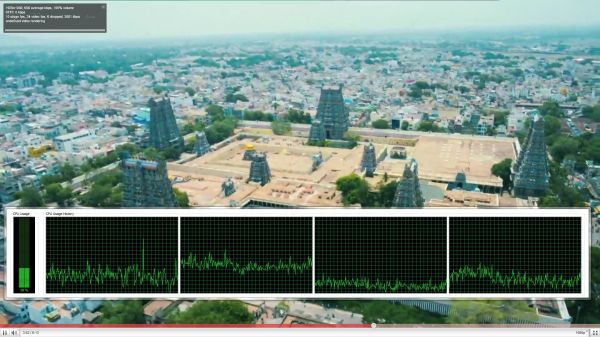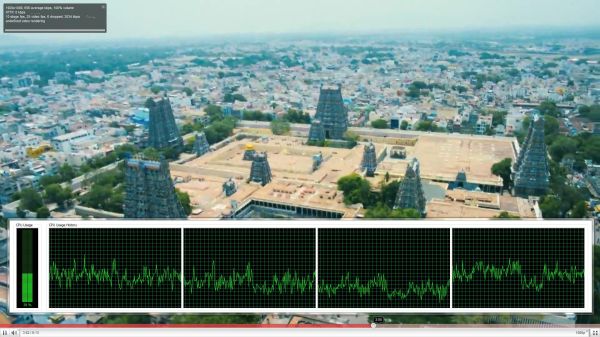Dell Zino HD 410 HTPC Review
by Ganesh T S on February 19, 2011 7:08 AM EST- Posted in
- HTPC
- Dell
- AMD
- Media Streamer
- ATI
The Zino 410 is covered quite nicely with respect to networking hardware. With support for both Gigabit Ethernet and 802.11n, it really doesn't matter if you keep the unit beyond cable reach from the router. All our network streaming tests were carried out with a 300 Mbps 802.11n network (currently provided in my lab location by a RT-N16 802.11n gigabit router from Asus). We were easily able to stream HD clips of more than 50 Mbps. HD YouTube videos and HD Netflix streaming had no issues.
While on the topic of network streaming, let us take a brief look at how the system performs while accessing online video services. We used Flash 10.1 in Firefox 3.6 with ATI Catalyst 11.1 for testing.
The first set of screenshots below show the CPU usage while playing back a 1080p YouTube video with and without hardware acceleration enabled. This is the same clip as the one used in the Core 100 and Vision 3D reviews. As can be seen, the GPU indeed supports Flash acceleration. However, the difference between the hardware accelerated and non-hardware accelerated CPU usage is around 11% only (39% for no hardware acceleration and 28% for hardware acceleration). We expect similar results for videos on Hulu.
1080p YouTube HD Streaming without Hardware Acceleration

1080p YouTube HD Streaming with Hardware Acceleration
Netflix streaming, on the other hand, uses Microsoft's Silverlight technology. Unlike Flash, hardware acceleration for the video decode process is not controlled by the user. It is upto the server side code to attempt GPU acceleration. Thankfully, Netflix does try to take advantage of the GPU's capabilities. This is evident from the A/V stats recorded while streaming a Netflix HD video at the maximum possible bitrate of 3.8 Mbps. While the video is definitely not 1080p, we observe that the CPU utilization of around 40% is higher than the CPU usage for a 1080p YouTube video.

Netflix HD Streaming with Hardware Acceleration
We suspect that the handling of the DRM in the case of Netflix streaming is done by the CPU, resulting in the higher usage.
Users of media streamers streaming online videos often have to put up with messages of the sort 'This content is not available on TV connected devices' or need to queue up the videos on a PC before accessing them through their media streamer box. HTPC users don't need to worry about any such limitations. For online media consumption, the Zino 410 is as good as the Core 100, but not as efficient as the Vision 3D.











69 Comments
View All Comments
plewis00 - Saturday, February 19, 2011 - link
I agree with you and was about to post this myself.If someone really wants a 2.5" hard disk why can't they use an adapter and remove the existing 3.5" unit. I bought a 2TB hard disk the other day for £60 (I'm in the UK), but that same amount of money would buy you a 500 or 640GB 2.5" model so I know what I'd rather have.
I'd actually say rather than a complaint, Dell should actually be praised for fitting a 3.5" drive in there.
JNo - Saturday, February 19, 2011 - link
Absolutely agree. I think you're analysis that 2.5" would be better is disappointing Ganesh. And I highly doubt that an SSD boot drive option would be beneficial to many people. This is an HTPC after all and affordability is key for what is a secondary PC.I have an Xtreamer (google it) and it cost only £99 and plays every hi def file(s) I've chucked at it including mkv, ts, blu-ray file structures and much more and supports hi def sound outputting as well. It is fanless too. In fact unless you want PVR functionality / internet too, it makes more expensive HTPCs redundant.
Only disappointment is that it only fits a 2.5" drive and the largest (at the time) 500Gb drive I put in was as much as a 1.5TB drive eco/green drive. And the new 3.5" eco/green drives are just as quiet as their 2.5" brethren. I think most people savvy enough to know they need an HTPC tend to have very large music / video collections so size is a big deal.
ganeshts - Sunday, February 20, 2011 - link
The Caviar Black 750 GB is specified to have a power consumption at full load of 8.4W [ http://www.wdc.com/en/library/sata/2879-701276.pdf ].The Scorpio Black 750 GB (2.5", 7200rpm) is specified to have a power consumption of 1.75W when active [ http://www.wdc.com/en/products/products.aspx?id=13... ]
My belief is that the extra ~7W could have been devoted to a better discrete GPU rather than having a 3.5" hard drive.
Our well reviewed ASRock Vision 3D and Core 100 both have 2.5" hard drives, and I have hardly seen any reader / reviewers on other sites complain.
Also, people savvy enough to think they need a HTPC also have an external storage solution (storage array or NAS), and the hard disk on the HTPC is just a temporary 'staging' ground.
I still stand by my suggestion to Dell to move to a 2.5" hard drive for the next generation Zino.
Zoomer - Wednesday, March 2, 2011 - link
I agree with taltamir on this. There is simply no reason to use 2.5" drives when there is space for 3.5". Some may buy this and use local storage. Even if they don't it's still cheaper to put a 3.5" in.Noise, most if not all HDDs can be set to reduce noise. Acoustic Managemet or something like that.
The 2TB WD caviar green only requires 4.5 W when reading/writing. That's just 2.75 W, and barely worth considering.
Maybe you can push dell to give people a choice. WD Green, Caviar black, or the 2.5" black. Why not the momentus XT?
JWade - Saturday, February 19, 2011 - link
I got the 410 to upgrade from the 400hd, i like it alot better. i got the dual core one not the quad core. it does everything i need it to and then some.I cant hear it make any noise at all, even when playing games with it. I use it with my 42" tv.
something of note, Dell did make an atom version of the Zino too.
ganeshts - Sunday, February 20, 2011 - link
Yes, I remember the Atom Zino.. But it wasn't called the Zino HD. Thanfully they moved away from the anaemic Atom for their first Zino HD.The first Zino HD was the Zino 400 and this is the second generation.
Glad to hear you like the Zino 410. It is a pretty good system for the price, and depending on your usage scenario you probably won't even notice the shortcomings!
Bignate603 - Saturday, February 19, 2011 - link
I see a huge amount of HTPCs without the option for a TV tuner. For something that claims to be a HTPC it seems like a pretty blatant omission. It should at least be an upgrade you could order with it.Taft12 - Saturday, February 19, 2011 - link
http://www.newegg.ca/Product/Product.aspx?Item=N82...hvakrg - Sunday, February 20, 2011 - link
Well, if you use a good HTPC program like Mediaportal you don't need tuner in all your HTPCs, all you need is a TVserver. That can then feed TV to all your HTPC clients around the house. It's a great way to do it because you won't have to pull coax to all your rooms.myangeldust - Saturday, September 10, 2011 - link
HDHomeRun dual tuners. Placed near your TV antenna or in your coaxial closet and connected to your home network. Any TV in the house could become an HTPC by simply installing the tuner's device driver. Fully compatible with Windows Media Center.